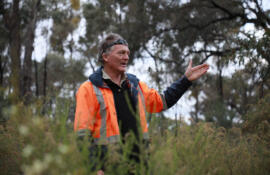The little mouse-like creature, soft grey with a yellow belly, appears at the base of an old tree, eyes wide and alert. Bendigo ranger Mark Toohey just has time to quietly point it out before it’s gone again, vanishing into the bush.

Trunk calls: Bendigo ranger Mark Toohey standing next to an ironbark tree in Crusoe Reservoir. Photo: Gwen Liu
It’s not mere luck that allows visitors to the Crusoe Reservoir a glimpse of the yellow-footed antechinus, a marsupial with a taste for insects and nectar, inhabits dry forests and woodlands, foraging and hiding in the nooks and crannies of tree hollows and fallen branches.
Victoria’s box-ironbark forests, like the one surrounding the reservoir, should provide prime habitat for this creature. So when he started working there back in 2005, Toohey was concerned that he rarely spotted them. This spurred a program to help them out.
When council workers had to cut down street trees, the logs were collected – especially gnarly specimens with hollows. They were distributed around Crusoe Reservoir to create conditions that might keep the antechinus and other hollow-loving creatures happy until the younger trees in the reserve matured.
“Five or 10 years later, I started seeing them,” says Toohey.

House calls: felled trees and branches provide habitat on the ground in Crusoe Reserve. Photo: Gwen Liu
Back then, Toohey saw it as an interim measure – helping nature take its course. But today he worries that the younger trees may never achieve maturity, with rising temperatures due to climate change bringing the prospect of more and fiercer forest fires.
“With hot and dry weather, the tree is going to grow slower and slower … the field gets drier and drier,” says Toohey. “Instead of having lots of moderate fires, we have more [and] bigger ones which cause more issues and kill more things.

Tiny homes: a nesting box in Bendigo’s Crusoe Reservoir. Photo: Liam Cochrane
“If you keep burning species’ homes every 10 or 20 years, and it takes 150 years for a house [hollow] to be built – where are they going to live?”
By 2050, under the world’s current greenhouse emissions trajectory, the annual average temperature in the Bendigo region will reach 22.5 degrees, two degrees higher than today, according to modelling by CSIRO and Bureau of Meteorology.

Bendigo’s Climate Change & Environment Strategy 2021-2026 predicts more extreme weather with intense storms, lower annual rainfall and increased bushfire risk. All pose direct threats to natural habitat.
Old trees and their hollows are crucial for many native tree-dwelling creatures. Among Bendigo’s threatened species, these include brush-tailed phascogales (another carnivorous marsupial), lace monitors (goannas), and powerful owls. Research shows large hollows in Australian native trees take over a century to form.

Branching out: an Owlet-nightjar in a tree hollow in Crusoe Reservoir, Bendigo. Photo: Liam Cochrane
These precious nooks are rare in Bendigo’s box-ironbark forests due to historic clearing, with some 83 per cent cut down across the state during the first century of colonisation, according to an 1890 report by the Conservator of Forests. Where forests have regrown, trees are slimmer and sparser, thinning out the habitat many creatures required to survive.

City of Greater Bendigo climate change and environment manager Michelle Wyatt says the council is concerned about the losses of larger trees to land development and to climate change, and the implications for species survival.
Australia has the worst record in the world for mammal extinctions, and one of the highest rates of species extinction overall.
“We need urgent interventions, well above our current rate … if we are to prevent further local species extinctions,” conclude the authors of Bendigo’s draft Biodiversity Strategy, due to be finalised in October 2023.
“There used to be 30 big trees per hectare in this place,” Toohey says, touching the biggest ironbark in the Crusoe Reservoir.
“Now I reckon I’ve got 50 big trees in 200 hectares.”




